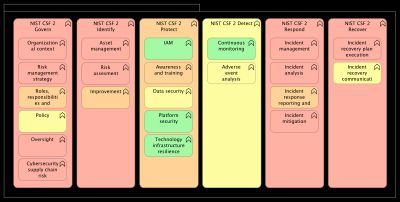NIST CSF Categories
The post below about combining ISO 27001 and NIST CSF shows an Enterprise Architecture (EA) model that maps the two standards.

- Jacco Meijer
- |
- Jun 27, 2025
Combining ISO 27001 and NIST CSF
How to use ISO 27001 and NIST Cyber Security Framework together
One of the advantages of NIST CSF is a well known set of categories that are useful as Enterprise Architecture (EA) business functions. This post is about the Maturity Model that NIST CSF describes as Tiers which can be used to classify the maturity of e.g. these business functions.
NIST CSF tiers
The full descriptions of the tiers is found in Appendix B of NIST CSF. Below is a brief summary that gives a quick overview.
| Tier | Name | Risk Governance | Risk Management |
|---|---|---|---|
| 1 | Partial | Ad hoc | Ad hoc |
| 2 | Risk Informed | Adds management approval | Adds awareness and sharing on informal basis |
| 3 | Repeatable | Adds company wide policy | Adds consistent methods |
| 4 | Adaptive | Adds company culture | Adds feedback loop |
The well known nature of the framework and the clear descriptions it provides is a major advantage over defining your own. As with many other maturity models, the model goes from the ad hoc state to a state that is continuously improving from experience.
The tiers explicitly being designed for cyber security make them a valuable benchmark for this specific field.
NIST CSF profiles
Related to the tiers, the NIST CSF defines the concept of profiles. From an EA perspective the CSF current profile corresponds to as is and the CSF target profile corresponds to to be.
The tiers are useful for defining a baseline as is or to be models and can be customized where needed.
Enterprise Architecture
Within EA the tiers are generally used by applying a metric to an element. The diagram below shows color coded capabilities for the four tiers.

NIST CSF tiers on CSF Categories
Using the color coded tiers on the CSF core functions and mid-level categories results in a diagram like the example below. This provides an organization with clear overview of the status of cybersecurity risk governance and management.

Conclusion
NIST CSF tiers are a useful way to complement an organization's cybersecurity risk management methodology. The tiers can be used as a benchmark and when risks for an organization increase, part of the strategy can be moving up to a higher tier.
For organizations that are ISO 27001 certified and willing to adopt the tiers, the post below is about how ISO 27001 and NIST CSF can be combined.

- Jacco Meijer
- |
- Jun 27, 2025
Combining ISO 27001 and NIST CSF
How to use ISO 27001 and NIST Cyber Security Framework together

























